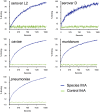Translation inhibition of the developmental cycle protein HctA by the small RNA IhtA is conserved across Chlamydia
- PMID: 23071807
- PMCID: PMC3469542
- DOI: 10.1371/journal.pone.0047439
Translation inhibition of the developmental cycle protein HctA by the small RNA IhtA is conserved across Chlamydia
Abstract
The developmental cycle of the obligate intracellular pathogen Chlamydia trachomatis serovar L2 is controlled in part by the small non-coding RNA (sRNA), IhtA. All Chlamydia alternate in a regulated fashion between the infectious elementary body (EB) and the replicative reticulate body (RB) which asynchronously re-differentiates back to the terminal EB form at the end of the cycle. The histone like protein HctA is central to RB:EB differentiation late in the cycle as it binds to and occludes the genome, thereby repressing transcription and translation. The sRNA IhtA is a critical component of this regulatory loop as it represses translation of hctA until late in infection at which point IhtA transcription decreases, allowing HctA expression to occur and RB to EB differentiation to proceed. It has been reported that IhtA is expressed during infection by the human pathogens C. trachomatis serovars L2, D and L2b and C. pneumoniae. We show in this work that IhtA is also expressed by the animal pathogens C. caviae and C. muridarum. Expression of HctA in E. coli is lethal and co-expression of IhtA relieves this phenotype. To determine if regulation of HctA by IhtA is a conserved mechanism across pathogenic chlamydial species, we cloned hctA and ihtA from C. trachomatis serovar D, C. muridarum, C. caviae and C. pneumoniae and assayed for rescue of growth repression in E. coli co-expression studies. In each case, co-expression of ihtA with the cognate hctA resulted in relief of growth repression. In addition, expression of each chlamydial species IhtA rescued the lethal phenotype of C. trachomatis serovar L2 HctA expression. As biolayer interferometry studies indicate that IhtA interacts directly with hctA message for all species tested, we predict that conserved sequences of IhtA are necessary for function and/or binding.
Conflict of interest statement
Figures






Similar articles
-
Identification of the base-pairing requirements for repression of hctA translation by the small RNA IhtA leads to the discovery of a new mRNA target in Chlamydia trachomatis.PLoS One. 2015 Mar 10;10(3):e0116593. doi: 10.1371/journal.pone.0116593. eCollection 2015. PLoS One. 2015. PMID: 25756658 Free PMC article.
-
The sRNA Regulated Protein DdbA Is Involved in Development and Maintenance of the Chlamydia trachomatis EB Cell Form.Front Cell Infect Microbiol. 2021 Jul 23;11:692224. doi: 10.3389/fcimb.2021.692224. eCollection 2021. Front Cell Infect Microbiol. 2021. PMID: 34368013 Free PMC article.
-
A small RNA inhibits translation of the histone-like protein Hc1 in Chlamydia trachomatis.Mol Microbiol. 2006 Jan;59(2):541-50. doi: 10.1111/j.1365-2958.2005.04949.x. Mol Microbiol. 2006. PMID: 16390448
-
Single-Inclusion Kinetics of Chlamydia trachomatis Development.mSystems. 2020 Oct 13;5(5):e00689-20. doi: 10.1128/mSystems.00689-20. mSystems. 2020. PMID: 33051378 Free PMC article.
-
One Face of Chlamydia trachomatis: The Infectious Elementary Body.Curr Top Microbiol Immunol. 2018;412:35-58. doi: 10.1007/82_2016_12. Curr Top Microbiol Immunol. 2018. PMID: 27197644 Review.
Cited by
-
Chlamydia trachomatis In Vivo to In Vitro Transition Reveals Mechanisms of Phase Variation and Down-Regulation of Virulence Factors.PLoS One. 2015 Jul 24;10(7):e0133420. doi: 10.1371/journal.pone.0133420. eCollection 2015. PLoS One. 2015. PMID: 26207372 Free PMC article.
-
Comparative Genome Analysis of 33 Chlamydia Strains Reveals Characteristic Features of Chlamydia Psittaci and Closely Related Species.Pathogens. 2020 Oct 28;9(11):899. doi: 10.3390/pathogens9110899. Pathogens. 2020. PMID: 33126635 Free PMC article.
-
A stress-induced small RNA modulates alpha-rhizobial cell cycle progression.PLoS Genet. 2015 Apr 29;11(4):e1005153. doi: 10.1371/journal.pgen.1005153. eCollection 2015 Apr. PLoS Genet. 2015. PMID: 25923724 Free PMC article.
-
Plasmid Negative Regulation of CPAF Expression Is Pgp4 Independent and Restricted to Invasive Chlamydia trachomatis Biovars.mBio. 2018 Jan 30;9(1):e02164-17. doi: 10.1128/mBio.02164-17. mBio. 2018. PMID: 29382731 Free PMC article.
-
Identification of proteins differentially expressed by Chlamydia trachomatis treated with chlamydiaphage capsid protein VP1 during intracellular growth.Arch Microbiol. 2017 Oct;199(8):1121-1131. doi: 10.1007/s00203-017-1381-2. Epub 2017 Apr 25. Arch Microbiol. 2017. PMID: 28444417 Free PMC article.
References
-
- World Health Organization (2001) Global prevalence and incidence of selected curable sexually transmitted infections: overview and estimates. - PubMed
-
- Cates W, Wasserheit JN (1991) Genital chlamydial infections: epidemiology and reproductive sequelae. Am J Obstet Gynecol 164: 1771–1781. - PubMed
-
- Barron AL, White HJ, Rank RG, Soloff BL, Moses EB (1981) A new animal model for the study of Chlamydia trachomatis genital infections: infection of mice with the agent of mouse pneumonitis. J Infect Dis 143: 63–66. - PubMed
Publication types
MeSH terms
Substances
Grants and funding
LinkOut - more resources
Full Text Sources
Research Materials

